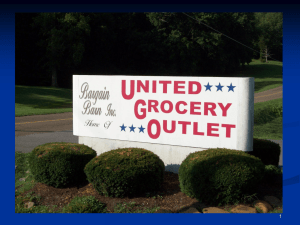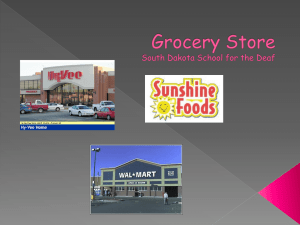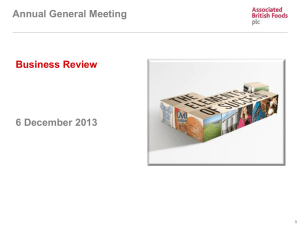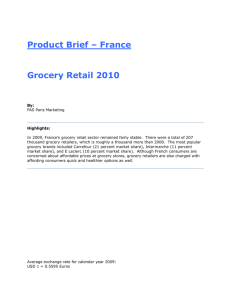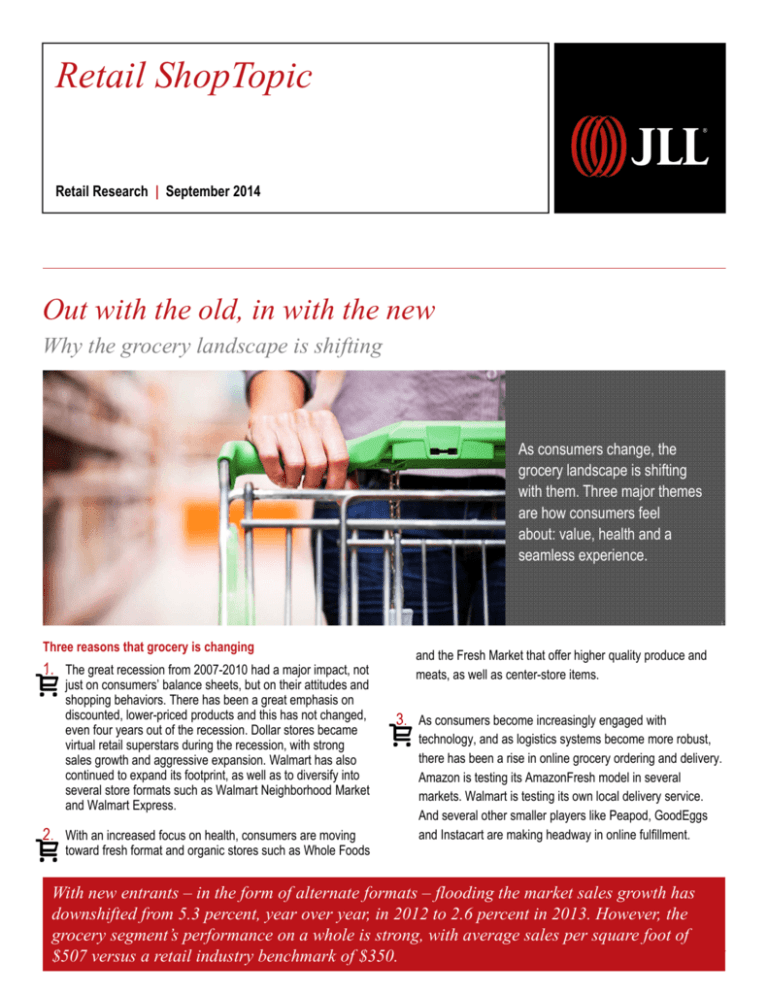
Retail ShopTopic
Retail Research | September 2014
Out with the old, in with the new
Why the grocery landscape is shifting
As consumers change, the
grocery landscape is shifting
with them. Three major themes
are how consumers feel
about: value, health and a
seamless experience.
Three reasons that grocery is changing
1. The great recession from 2007-2010 had a major impact, not
just on consumers’ balance sheets, but on their attitudes and
shopping behaviors. There has been a great emphasis on
discounted, lower-priced products and this has not changed,
even four years out of the recession. Dollar stores became
virtual retail superstars during the recession, with strong
sales growth and aggressive expansion. Walmart has also
continued to expand its footprint, as well as to diversify into
several store formats such as Walmart Neighborhood Market
and Walmart Express.
2. With an increased focus on health, consumers are moving
toward fresh format and organic stores such as Whole Foods
and the Fresh Market that offer higher quality produce and
meats, as well as center-store items.
3. As consumers become increasingly engaged with
technology, and as logistics systems become more robust,
there has been a rise in online grocery ordering and delivery.
Amazon is testing its AmazonFresh model in several
markets. Walmart is testing its own local delivery service.
And several other smaller players like Peapod, GoodEggs
and Instacart are making headway in online fulfillment.
With new entrants – in the form of alternate formats – flooding the market sales growth has
downshifted from 5.3 percent, year over year, in 2012 to 2.6 percent in 2013. However, the
grocery segment’s performance on a whole is strong, with average sales per square foot of
$507 versus a retail industry benchmark of $350.
Additional competition translates to consolidation for traditional grocery
•
It’s been happening for a while now. Other retail categories
have been slowly but inexorably impinging on
supermarkets’ territory – adding more and more grocery
shelves to their aisles over time.
•
With razor-thin margins and an already competitive
environment, traditional supermarkets are faltering under
the additional pressure of these entrants into the grocery
landscape. This has translated into consolidations and
mass closings.
How the grocery landscape will shift from 2013 to 2018
• Whereas once consumers bought all their groceries at one
location, this is no longer the case. Consumers are now
splitting their grocery shopping across multiple channels – as
many as five. As a result, traditional supermarkets* are losing
market share.
• By 2018, traditional supermarkets’ share of grocery dollars will
have shrunk 300 basis points to 37.2 percent. Consumers are
spending more of their time and dollars in fresh format* and
limited assortment* stores, supercenters* and e-commerce*.
• With regard to expansion plans, fresh format stores will see
the most aggressive gain relative to their existing footprint,
thanks to robust sales growth. This is not surprising given that
75.0 percent of consumers surveyed prioritize fresh produce
as a major driver of where they shop. Moreover, Millennials
and Boomers alike are focusing more on healthy eating
choices and creatively prepared meals.
• Dollar stores* and convenience stores* top the list of the
highest nominal number of new stores planned, continuing the
trend we have seen over the last few years. As consolidations
and closings continue, traditional supermarkets will see a net
reduction in store count.
Share of sales revenue
Alternate formats gain the most market share from 2013-2018
100%
90%
80%
70%
60%
50%
40%
30%
20%
10%
0%
E-commerce
14.7%
2.5%
2.9%
5.4%
5.2%
9.0%
14.7%
17.3%
18.9%
Wholesale
1.8%
2.5%
3.9%
5.3%
8.5%
Examples:
• Kroger, for instance, recently acquired regional player
Harris-Teeter for $2.6 billion
• Albertson’s purchased United Supermarkets in late 2013
• Yucaipa acquired 150 Fresh & Easy locations
• Safeway closed all of its 72 Dominick’s stores in
Chicago, resulting in a return of 4.5 million square feet of
space to the market, spiking vacancies in the metro by 80
basis points
Supercenters will see the greatest increase in market share by 2018
Change in market share (in bps)
Supercenter
160
Fresh format/limited assortment
150
E-commerce
70
Wholesale
50
Dollar store
40
Dollar store
0
Drug
Traditional supermarkets
-10
-300
Source: Willard Bishop
Fresh-format groceries will dramatically increase store count by 2018
Increase in sales 2013-2018
62.8%
3.6%
19.0%
10.6%
10.6%
7.9% 12.7%
7.1%
22.9%
17.2%
31.2%
28.9%
37.2%
-2.2%
Traditional
supermarkets
Drug
C-stores Wholesale Supercenter
Dollar
store
2018 market share
Source: Willard Bishop 2014
*Grocery channel definitions on page 3
Limited
assortment
Fresh
format
Source: Willard Bishop 2014
Traditional supermarkets’ store count will fall by 2018
Dollar store
Change in store count
Fresh format/limited
assortment
Drug
11,199
7,848
Supercenter
Traditional
supermarkets
2013 market share
38.4%
8.3%
Total C-stores
40.2%
92.2%
% change in store count
147
320
657
668
1,839
-576
Traditional Wholesale Limited Supercenter
supermarkets
assortment
Fresh
format
Drug
Dollar
store
C-stores
Source: Willard Bishop 2014
JLL | Retail Research | ShopTopic | September 2014
2
In terms of individual performance, Whole Foods leads with sales
of over $930 per square foot and expansion plans of 38 new
stores within the next year. These stores fall into the alternate
formats of fresh format– a clear illustration of what is happening
within the market.
Grocery channel definitions
Category
Definition
Traditional
Supermarket
• Offering a full line of
groceries, meat
and produce
• At least $2 million in
annual sales
• Carry between 15,000
and 60,000 SKUs
Grocery store sales p.s.f. and store opening plans
1,800
Average sales/s.f.
1,600
60
Store openings
50
1,400
1,200
1,000
800
600
400
40
38
$937
30
$552
$490
$496
$490
20
20
30
$442
20
$419
15
200
0
Source: PNC Bank, Chainlinks, Retail LeaseTrac
5
$393
$335
2
3
$325
10
20
Fresh Format • Emphasize perishables
• Offer ethnic, natural,
organic items
Limited
Assortment
• Low-priced grocery store
• Offer limited assortment
of center-store
and perishables
• Fewer than 2,000 SKUs
Convenience
Stores
• Small high-margin store
• Edited selection of items
Wholesale
Club
• Membership retail/
wholesale hybrid
• Varied selection and
limited variety
• Over 120,000 s.f.
10
0
*Trader Joe’s data not included
The rise of e-commerce
Finally, it cannot be ignored that e-commerce is slowly taking a
greater share of grocery dollars. From 2013 to 2018, the growth in
e-commerce grocery revenue is projected to be 57.4 percent,
quite a significant figure; however, it is helpful to note that the
overall share remains small at 2.5 percent in 2018. While this is
reassuring news for bricks-and-mortar players, it will still be critical
to keep an eye on emerging trends within the grocery delivery
space for several reasons. If Amazon figures out a successful
solution to a wide-scale implementation of its AmazonFresh
model, it poses a significant threat to groceries, particularly
supermarkets with thin margins. Secondly, given that logistics for
delivery may lie in crowdshare programs like Uber, this may have
important implications for local stores looking to stay ahead of the
curve and offer enhanced services to its existing customers.
Examples
Supercenters • Hybrid of large traditional
supermarket and mass
merchandiser
• Offer wide variety of food
and non-food items
• Average more than
170,000 s.f.
• Devote as much as 40.0% of
space to grocery items
Dollar Stores • Small store format selling
food and consumables at
aggressive price points
• Food between 20.0%-66.0%
of sales volume
Drug Store
• Prescription-based drug
store that generates 20.0%
or more of sales from
consumables, general
merchandise and seasonal
E-commerce
• Food and consumables
ordered using Internet via
any device, regardless of
payment or fulfillment
method
JLL | Retail Research | ShopTopic | September 2014
3
About JLL
JLL (NYSE:JLL) is a professional services and investment management firm offering specialized real estate services to clients seeking increased value
by owning, occupying and investing in real estate. With annual revenue of $4 billion, JLL operates in 75 countries worldwide. On behalf of its clients, the
firm provides management and real estate outsourcing services for a property portfolio of 3 billion square feet and completed $99 billion in sales,
acquisitions and finance transactions in 2013. Its investment management business, LaSalle Investment Management, has $47.6 billion of real estate
assets under management. For further information, visit www.jll.com.
About JLL Research
JLL’s research team delivers intelligence, analysis, and insight through market-leading reports and services that illuminate today’s commercial real
estate dynamics and identify tomorrow’s challenges and opportunities. Our 300 professional researchers track and analyze economic and property
trends and forecast future conditions in over 70 countries, producing unrivalled local and global perspectives. Our research and expertise, fueled by realtime information and innovative thinking around the world, creates a competitive advantage for our clients and drives successful strategies and optimal
real estate decisions.
For more information, please contact:
Aaron Ahlburn
Director of Research,
Industrial and Retail – Americas
+1 424 294 3437
aaron.ahlburn@am.jll.com
Keisha McDonnough
Senior Research Analyst, Retail
+1 954 990 0844
keisha.mcdonnough@am.jll.com
www.jllretail.com
©2014 Jones Lang LaSalle IP, Inc. All rights reserved. No part of this publication may be reproduced by any means, whether graphically, electronically, mechanically or otherwise howsoever, including without
limitation photocopying and recording on magnetic tape, or included in any information store and/or retrieval system without prior written permission of Jones Lang LaSalle. The information contained in this
document has been compiled from sources believed to be reliable. Jones Lang LaSalle or any of their affiliates accept no liability or responsibility for the accuracy or completeness of the information contained
herein and no reliance should be placed on the information contained in this document.


